Disposing of waste is an everyday occurrence. Waste comes from dogs, cows, horses, and people. Harmful pathogens such as bacteria, viruses, and parasites from failing septic systems and animal waste can pollute water. Other waste such as medicines and household chemicals flushed down the drain may also make its way to groundwater or waterways. In this chapter you will learn the best ways to keep harmful waste out of our waterways. Doing so can save you money and keep you and your family safe from illness.
In this Guideline:
- References for Guideline 1
-
A Homeowners Guide to Septic Systems, United States Environmental Protection Agency, EPA-832-B-02-005. 15 p; Revised March 2005.
Homeowners Guide to Onsite Sewage Systems, Kitsap Public Health District, 24 p.
Small Farm Composting Guide, USDA Natural Resources Conservation Service, Lynden Field Office. 24 p.
Horses for Clean Water, Whatcom Conservation District, 76 p, 2003.
Scoop the Poop, Bag it, Place it in the Trash, Suzi Wong Swint, 36 p. Snohomish Surface Water Management, May 2014.
Backyard Composting, Craig Cogger and Dan Sullivan, 7 p, WSU Extension, PUB EB1784E
Microplastics in Consumer Products and the Marine Environment, 10 p, 5 Gyres Institute, 2013.
- Discovering how waste affects human, shellfish and marine life
-
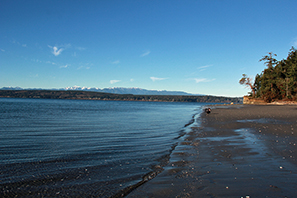 Shellfish, such as oysters, mussels, and clams are filter feeders that subsist by eating tiny particles floating in the water. Bacteria found in the feces of humans and other warm-blooded animals are monitored in recreational and shellfish harvesting areas because they are good indicators that other harmful pathogens may be present. When high bacteria levels are found, beaches are closed to shellfish harvesting and swimming.
Shellfish, such as oysters, mussels, and clams are filter feeders that subsist by eating tiny particles floating in the water. Bacteria found in the feces of humans and other warm-blooded animals are monitored in recreational and shellfish harvesting areas because they are good indicators that other harmful pathogens may be present. When high bacteria levels are found, beaches are closed to shellfish harvesting and swimming.How to know when water is polluted
Bacterial pollution monitoring is conducted by the Washington Department of Health, the Washington Department of Ecology, and by some counties, tribes, and local municipalities. In a given area the monitoring is often well coordinated and done on a regular basis at various locations. Unfortunately, monitoring is expensive and is often only done on a monthly basis, which may not catch contamination quickly enough to prevent harm. Before you harvest shellfish call the hotline at 1-800-562-5632 to see the status of your beach or visit the Washington Department of Fish and Wildlife website at: wdfw.wa.gov/fishing/shellfish.
- Eliminating Medical, Chemical, & Microplastics Waste
-
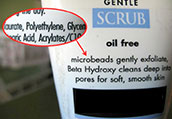 Whether you live in a house connected to a sewer or you use a septic system, it’s very important to limit what you flush down your toilet or pour down your sink. The only things you should flush down the toilet are human waste and/or toilet paper, period. Anything else should go into the trash. Even items labeled “flushable” or that say they are safe for the sewer or septic systems should be discarded in the trash. These items can increase the frequency that you’ll need to pump your septic tank or cause clogs in your pipes, which can cause overflows that can damage property and make people sick.
Whether you live in a house connected to a sewer or you use a septic system, it’s very important to limit what you flush down your toilet or pour down your sink. The only things you should flush down the toilet are human waste and/or toilet paper, period. Anything else should go into the trash. Even items labeled “flushable” or that say they are safe for the sewer or septic systems should be discarded in the trash. These items can increase the frequency that you’ll need to pump your septic tank or cause clogs in your pipes, which can cause overflows that can damage property and make people sick.Avoid harming water quality, fish and wildlife, and protect your septic or sewer treatment plant by doing the following:
- Disposing of drugs:
Drugs, medications, and other pharmaceuticals should never be flushed or poured down the sink. If you are concerned about keeping medications away from children and pets, first mix them with old coffee grounds or kitty litter before disposing them in the garbage. Some pharmacies and police stations accept narcotics and other prescription drugs for free and safe disposal.
- Disposing of chemicals:
Never pour harsh cleaning products, chemicals, solvents, antifreeze, automotive fluids, cements and glues, nail polish remover, or pesticides into the toilet or down the sink. Do not use the sink to clean up after painting, whether the paint is oil or water based. Paints can harm your septic system, and if you are connected to sewer the paints may enter Puget Sound and harm marine life. Check with your solid waste facility to see if they accept any of these items; many offer free disposal of hazardous substances.
- Microplastics in personal care products:
Many common products used in the home contain tiny beads of plastic, called microplastics. These products include toothpaste, deodorants, eye shadow, exfoliates, body washes, and abrasives used in hand-washing products. The tiny beads wash down the drain, through the filters at the sewage treatment plant, and into the water. These microplastics can be ingested by marine life, sickening or killing them. Avoid purchasing or using products that may contain microplastic beads. Look for the ingredient polyethylene. If the word is followed by a comma, you may have found a source of microplastics.
Shellfish, such as oysters, mussels, and clams are filter feeders that subsist by eating tiny particles floating in the water. Bacteria found in the feces of humans and other warm-blooded animals are monitored in recreational and shellfish harvesting areas because they are good indicators that other harmful pathogens may be present. When high bacteria levels are found, beaches are closed to shellfish harvesting and swimming.
How to know when water is polluted
Bacterial pollution monitoring is conducted by the Washington Department of Health, the Washington Department of Ecology, and by some counties, tribes, and local municipalities. In a given area the monitoring is often well coordinated and done on a regular basis at various locations. Unfortunately, monitoring is expensive and is often only done on a monthly basis, which may not catch contamination quickly enough to prevent harm. Before you harvest shellfish call the hotline at 1-800-562-5632 to see the status of your beach or visit the Washington Department of Fish and Wildlife website at: wdfw.wa.gov/fishing/shellfish.
- Disposing of Yard Waste
-
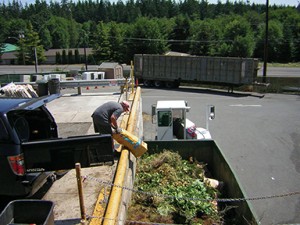 Dumping yard waste over a bluff, into a lake or stream, or into the marine water for the tide to take away was once a common practice. Today we know that leaves and grass clippings dumped into these areas can cause algal blooms and reduce oxygen levels in the water. The recommended option for disposing of leaves, grass clippings and other yard waste is to compost them at home or use a yard debris collection service, which may be offered by your local solid waste collector. Your WSU Extension or local Conservation District offices are good sources of information on home composting. For more information visit: gardening.wsu.edu/compost-and-mulch.
Dumping yard waste over a bluff, into a lake or stream, or into the marine water for the tide to take away was once a common practice. Today we know that leaves and grass clippings dumped into these areas can cause algal blooms and reduce oxygen levels in the water. The recommended option for disposing of leaves, grass clippings and other yard waste is to compost them at home or use a yard debris collection service, which may be offered by your local solid waste collector. Your WSU Extension or local Conservation District offices are good sources of information on home composting. For more information visit: gardening.wsu.edu/compost-and-mulch.
- Managing Livestock Waste
-
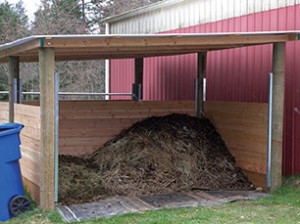 To protect the quality of our fresh and marine waters, it’s very important for livestock owners to pick-up, store, and utilize or dispose of manure properly.
To protect the quality of our fresh and marine waters, it’s very important for livestock owners to pick-up, store, and utilize or dispose of manure properly.Some of the beneficial reasons for managing livestock manure include:
- Protecting livestock and horses from living in an unhealthy environment. Manure can contaminate animal feed and sicken animals.
- Avoiding creation of a breeding ground for nuisance insects that carry diseases.
- Lessening the chance of parasite re-infestation, which can happen when internal parasites hatch in the manure and mud and are then ingested by the animals.
- Preventing the contamination of groundwater and surface waters by manure, which is harmful to fish, aquatic life, and people, and stimulates growth of aquatic weeds.
In order to benefit from the natural fertilizers in your animal manure, improve your soil, and reduce the costs of chemical fertilizers, manage your manure by:
- Collecting manure from stalls, paddocks, confinement areas and pastures every day or two, storing it in a covered storage bin or an area covered with a tarp. The tarp will keep the manure from being saturated in the winter and from weed seeds landing on it in the summer.
- Applying composted manure to pastures only during the growing season, April through October. Apply about a half inch of compost at a time but limit coverage to a maximum of 3–4 inches per year. This provides macro and micro nutrients to the soil and adds organic material that improves water infiltration, moderates compaction, and provides healthy probiotics to the soil. Compost also improves the pH of the soil, making it more ideal for grass growth.
- Selling, trading or giving away composted manure which is often coveted by community gardens, neighbors, nurseries, garden clubs, or topsoil businesses.
- Scooping pet waste
-
Preventing contamination from dog waste in our yards, streams, and Puget Sound is a simple task:
- Scoop the poop.
- Place it in a plastic bag and seal it.
- Place it in the trash.
- Wash your hands
Cat litter should be placed in a plastic bag and disposed of in the trash.
If pet waste is left on lawns, streets, trails, or in parks, rainwater can carry it into roadside ditches or storm drains which often drain directly into lakes, creeks, rivers and eventually into Puget Sound. This untreated waste may contain E. coli and other harmful bacteria, viruses, roundworms, and other pathogens. Some of these contaminants can last in your yard as long as four years and can sicken adults, pets, and children who play in their yards. Bacteria and other disease-causing organisms in pet waste are also one of the top causes of contamination in our streams. This contamination can make people and pets sick if they contact the water. One gram of pet waste, approximately the size of a pea, can contain up to 23 million fecal coliform bacteria, as well as other pathogens. When carried into Puget Sound, these pathogens can end up in shellfish, sickening people who eat them and causing closure of recreational and commercial shellfish growing areas. This not only restricts our ability to gather shellfish for personal consumption, but can have a significant impact on our economy.
- Signs of a failing septic system
-
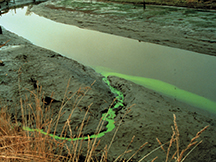 Septic systems are designed to have a lifespan of 20 to 30 years, although many last longer. The most common cause of early failure is improper maintenance. A well maintained system is one that is inspected at the recommended frequency and maintained as necessary. A system that is not pumped when needed will result in a build-up of sludge and floating solids, such as greases and toilet paper, inside the septic tank. If these build up too much they will flow out of the tank into the drain field, causing it to become clogged beyond repair. Other causes of failure can include pipes blocked by roots, crushed pipes, over-saturation of the soils, flushing of inappropriate items (like cigarette butts), poor design, or poor installation.
Septic systems are designed to have a lifespan of 20 to 30 years, although many last longer. The most common cause of early failure is improper maintenance. A well maintained system is one that is inspected at the recommended frequency and maintained as necessary. A system that is not pumped when needed will result in a build-up of sludge and floating solids, such as greases and toilet paper, inside the septic tank. If these build up too much they will flow out of the tank into the drain field, causing it to become clogged beyond repair. Other causes of failure can include pipes blocked by roots, crushed pipes, over-saturation of the soils, flushing of inappropriate items (like cigarette butts), poor design, or poor installation.YOU KNOW YOU HAVE A SERIOUS PROBLEM IF YOU EXPERIENCE ANY OF THE FOLLOWING
- Sewage backing up in your toilets, sinks, or bathtubs.
- Slow flushing toilets, as well as drains that are draining much slower, even after using plungers or “plumbers’ snakes.”
- Water pooling in your yard or accumulating near your septic tank. This water may or may not be accompanied by a foul odor.
- Black or dark grey stains in soil or grasses on the drainfield or surrounding areas.
- Overly moist or mushy areas in your drainfield area.
- Algae growth on subsurface drainage pipe outlets, bulkheads, or visible seeps on the beach or along the stream.
If your septic system appears to be failing:
- Avoid using septic system “miracle cures” that promise to get rid of the sludge and scum in your system. “Miracle cures” may dissolve the sludge and scum, sending dissolved particles into your drainfield, potentially clogging the soils in the drainfield and requiring expensive drainfield repair or replacement.
- Contact your local health department or surface water agency to find out if their staff may be able to assess your situation and give you advice on how to solve the problem. Your local conservation district may also be helpful. These organizations may also be able to connect you with special loan programs for repairing your system.
- Fence off areas if there is liquid waste seeping to the surface of your yard so that pets and people, especially children, are not in contact with the liquid.
- Conserve water as described in Guideline 8. This can extend the life of your system if it turns out it has not failed completely.
- Have your system pumped and filters cleaned, combined with some drastic water conservation around the home, may help solve the problem temporarily, as an empty tank can hold up to several days of waste.
Ways to save money
Maintaining and repairing your septic system can be expensive. Because of the importance of maintaining your system to public health, there are sometimes coupons, classes, incentives, and low-interest loans available. Check with your health department, surface water agency, or conservation district to see if they have any incentives.
- Protecting your drainfield
-
 Your drainfield is critical to the health of your septic system and needs to be protected. The pipes and other components in your system may not be buried very deep below ground and could be easily crushed. The soils in your drainfield contain oxygen-loving bacteria that break down and filter the effluent. If the area is compacted by driving or parking on it, the bacteria won’t be as effective and will reduce the ability of the water to percolate through the soil. You will also want to avoid doing anything that overwhelms the system with too much water.
Your drainfield is critical to the health of your septic system and needs to be protected. The pipes and other components in your system may not be buried very deep below ground and could be easily crushed. The soils in your drainfield contain oxygen-loving bacteria that break down and filter the effluent. If the area is compacted by driving or parking on it, the bacteria won’t be as effective and will reduce the ability of the water to percolate through the soil. You will also want to avoid doing anything that overwhelms the system with too much water.To protect the lifespan of your drainfield, avoid these activities.
Building structures on the drainfield, including tool or garden sheds, decks, sport courts, patios, swing sets, sand boxes, or compost bins.
Parking or driving vehicles or construction equipment on the drainfield.
Planting trees and large shrubs near the drainfield. They should be planted at least 30 feet away to prevent roots from getting into and breaking or clogging the drainfield pipes.
Using a rototiller which could damage the system parts that are close to the surface.
Over irrigating in the drainfield area, as this could saturate the soil and decrease the ability of the system to function properly.
Directing water from your downspouts and surface water runoff onto your drainfield.
Burning piles of leaves or branches over the drainfield, as the heat could damage the plastic pipes below, if they are buried shallowly.
Using plastic sheeting over these areas in an attempt to block weed growth.
Using too much topsoil or compost. Limit to no more than two to three inches over the drainfield.
A good rule of thumb for landscaping over drain fields is to use shallow rooted plants.

Drainfield being installed Many grasses have shallow root systems and are the simplest and most frequently recommended plantings over the drainfield. Choose a traditional lawn or perhaps an un-mowed meadow. You may include permeable pathways, garden ornaments, bird baths, sundials, tables and benches.
In sunnier locations, perennial gardens can be created with mixes of ornamental grasses of different heights and can be inter-planted with ground covers, small bulbs, and sun loving perennials as well as smaller, shallow rooted shrubs. Avoid larger ornamental grasses and bamboo, which are known to harm septic fields.
TIP: Avoid planting vegetables over your drainfield. Vegetables often need daily watering and excess water in the soil reduces the drainfield’s ability to treat wastewater. Roots of some vegetables may grow deep enough to damage or clog drain pipes. If the drainfield is not working properly, the effluent in the drain field could contaminate the vegetables.
- Maintaining your septic system
-
Maintaining your septic system is a good investment. Here is a checklist of actions you can take to ensure your system has a long life:
- Get a copy of your septic system’s “as-built” drawing from your Health Department if you do not have one. This drawing should show the location of your septic tank, drainfield, and all septic parts.
- Ensure that no vehicles or heavy machinery drive over any portion of your system.
- Keep records of any pumping or repairs.
- Inspect your system regularly. Depending on the type of system you have, the recommended inspection frequency may vary from every 6 months to every three years at most. Check with your Health Department to see how often you need to have your type of system inspected. Some counties allow you to complete your own inspection, and offer literature, classes, or videos on how to do so.
- Pump your system when necessary.
- Clean septic tank filters as recommended or at least annually, if you have them.
- Install inspection risers (extension tubes from the top of the tank to the surface that makes it easier to access your system to inspect or pump).
- Spread out the timing of water use around the house. Take showers and baths when the dishwasher or washing machine is not in use. Limit dishwashing or laundry loads to one cycle daily or space out loads to allow the system to process the water.
- Reduce water use. Guideline 8 has some great ideas on how to conserve water.
- Consider renting a port-a-potty for large events to avoid putting stress on your system.
- How your septic system works
-
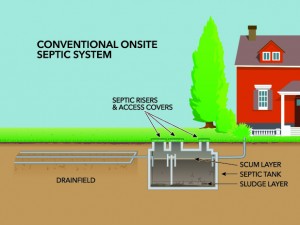 All septic systems are composed of a septic tank and drainfield. Wastewater from your household flows into the septic tank, where heavy solids settle to the bottom of the tank and form a layer of sludge. Grease, toilet paper, and other light solids float to the top and form a scum layer. In between the sludge and the scum is a semi-clear layer of wastewater called effluent that does not include solids. As more wastewater enters the septic tank, the clear effluent layer of the tank flows through an outlet in the tank to the drainfield in your yard. The “good” bacteria living in the soil clean the wastewater by consuming harmful bacteria and viruses before this wastewater seeps into groundwater.
All septic systems are composed of a septic tank and drainfield. Wastewater from your household flows into the septic tank, where heavy solids settle to the bottom of the tank and form a layer of sludge. Grease, toilet paper, and other light solids float to the top and form a scum layer. In between the sludge and the scum is a semi-clear layer of wastewater called effluent that does not include solids. As more wastewater enters the septic tank, the clear effluent layer of the tank flows through an outlet in the tank to the drainfield in your yard. The “good” bacteria living in the soil clean the wastewater by consuming harmful bacteria and viruses before this wastewater seeps into groundwater.The “good” bacteria in the septic system do not completely decompose the sludge or scum layers, so the layers continue to grow, slowly filling up the tank over time. These layers will eventually need to be pumped out by a professional septic pumper. No special additives are necessary or recommended.
There are several types of septic systems, and it is important to understand what kind you have and the requirements for its specific maintenance and inspection. The most common type is the gravity system, which does not require a pump to operate. Others include the pressure distribution system, sand filter system, mound system, and aerobic treatment units such as the Glendon BioFilter system.
- What should go down the drain
-
Whether you are connected to a large sewer system or your own onsite septic the only things that should go down the drain are human waste, toilet paper, mild soaps and detergents. Many items can clog the screens at your community’s sewage treatment plant or compromise your septic tank or drainfield—even those that say they are “flushable.” To avoid damaging your septic system or community sewage treatment plant, you should:
- Limit use of chlorine bleach to less than ½ cup per laundry load. Bleach kills the “good” bacteria in the tank and drainfield.
- Avoid using a garbage disposal, as the microbes in your septic tank don’t do a good job of breaking down undigested fruit, coffee grounds, eggshells, vegetables, and meats.
- Use the trash bin to dispose of used baby wipes, cleaning wipes, facial tissues, sanitary napkins, tampons, condoms, band aids or bandages, cotton balls or swabs, Q-tips, dental floss, disposable diapers, hair, and paper towels.
- Keep kitty litter and pet waste out of the toilet. These do not break down like human waste and should be bagged and placed in the trash.
- Use an ashtray, not the toilet, for cigarette butts and matches. They do not disintegrate and can harm your septic system and clog your drainfield.
- Use drain screens to keep hair, fruit sticker labels, and other small items from going down the drain.
- Scrape cooled grease and other food waste into the compost or trash before washing, so there is less work for your septic to do.
- Use a drain snake for plumbing system clogs, which is readily available at hardware stores, or follow this recipe:
- Mix ½ cup baking soda, ½ cup vinegar, and ½ cup boiling water.
- Pour quickly into clogged drain and let stand for 2–3 minutes.
- Then flush with water.
- The differences between septic and sewer
-
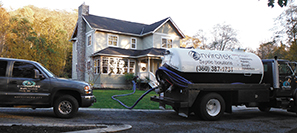 Everyone uses running water and flush toilets in their home or work place. The water running down the drain and toilet goes to either a private or community septic system or a public sewer system. If you have a septic system, you have a personal responsibility to maintain it and protect your investment. If you are on sewer, you pay a monthly bill, and someone else manages a treatment plant for your community. No matter how human waste is handled, there are steps you can take to protect your personal investment or the investment your community has made in a treatment plant.
Everyone uses running water and flush toilets in their home or work place. The water running down the drain and toilet goes to either a private or community septic system or a public sewer system. If you have a septic system, you have a personal responsibility to maintain it and protect your investment. If you are on sewer, you pay a monthly bill, and someone else manages a treatment plant for your community. No matter how human waste is handled, there are steps you can take to protect your personal investment or the investment your community has made in a treatment plant.
Spotlight
Resources
- Back Yard Composting, WSU Extension Home Garden Series
- Pet Waste: Scoop the Poop, Snohomish Surface Water Management